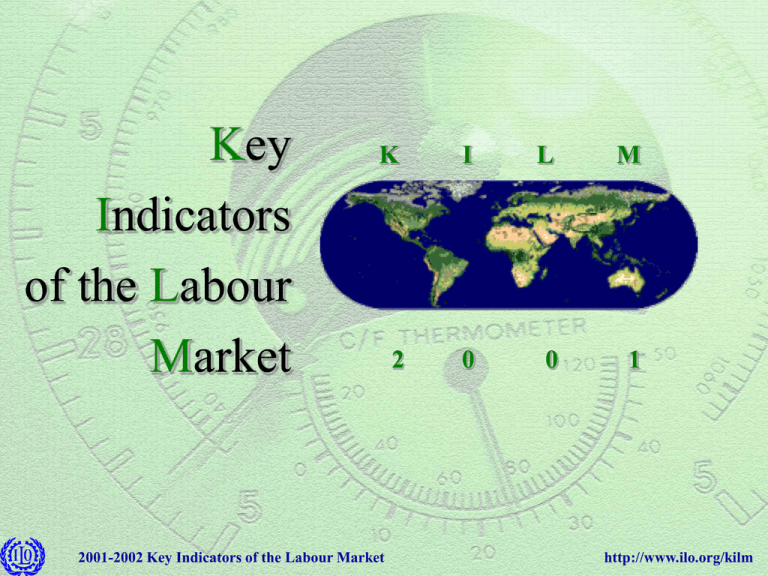Change in the world of work
advertisement

Key Indicators of the Labour Market K I L M 2 0 0 1 2001-2002 Key Indicators of the Labour Market http://www.ilo.org/kilm Globalization and Technological Advances As we enter a new millennium, it is increasingly clear that we are affected as much by global events and developments as by what occurs within our own communities. 2001-2002 Key Indicators of the Labour Market http://www.ilo.org/kilm Globalization and rapid technological advances are giving rise to increasing labour mobility and expanding business and employment opportunities. As a result, individuals are becoming more and more uncertain about their employment situations. Thus, globalization is particularly relevant to the world of work. 2001-2002 Key Indicators of the Labour Market http://www.ilo.org/kilm What is the KILM? 2001-2002 Key Indicators of the Labour Market http://www.ilo.org/kilm Timely and focused information on the world’s labour markets is essential. We need information that can help to answer such questions as: What types of economic activities are people engaged in? What is the size and composition of the labour force? How many hours do people work and how much do they earn for this work? How many people are without work and looking for work? What types of inequalities exist, for example in terms of earnings and employment situation? Are earnings keeping pace with the cost of living? How are youth and women faring in the labour market? 2001-2002 Key Indicators of the Labour Market http://www.ilo.org/kilm At the national level statistical information on labour markets are generally developed and analysed by statistical services and labour ministries. At the global level, the International Labour Office (ILO) plays a vital role in assembling, analysing and disseminating such information to the world community through projects such as the Key Indicators of the Labour Market (KILM). 2001-2002 Key Indicators of the Labour Market http://www.ilo.org/kilm In 1996, the Employment Policies Committee of the International Labour Conference, recognizing the need of governments and the social partners for timely and accurate information on labour market developments, requested that the ILO: Develop a set of labour market indicators Widen the availability of labour market indicators in order to monitor employment trends The 1999 KILM was the first product developed to meet these objectives. 2001-2002 Key Indicators of the Labour Market http://www.ilo.org/kilm What does the KILM contain? 2001-2002 Key Indicators of the Labour Market http://www.ilo.org/kilm The selection of the indicators was a collaborative effort among the ILO, OECD and national offices. Criteria for selection of the indicators: The indicator is conceptually relevant. Data are available for the indicator. The indicator is comparable across countries and regions. 2001-2002 Key Indicators of the Labour Market http://www.ilo.org/kilm When developing indicators, one must strike a balance between: Coverage Maximize scope of coverage, i.e., provide the greatest number of data points for the greatest number of countries 2001-2002 Key Indicators of the Labour Market Comparability Harmonize the indicators across countries and time (same type of sources, sampling procedures, methodologies and definitions) http://www.ilo.org/kilm Key Indicators of the Labour Market • Labour force participation rate • Employment-to-population ratio • Status in employment • Employment by sector • Part-time workers • Hours of work • Informal sector employment • Unemployment • Youth unemployment • Long-term unemployment Unemployment by educational attainment Time-related underemployment Inactivity rate Educational attainment and illiteracy Manufacturing wage indices Occupational wages and earnings indices Hourly compensation costs Productivity and unit labour cost Labour market flows Poverty and income distribution 2001-2002 Key Indicators of the Labour Market http://www.ilo.org/kilm Data Providers Initial efforts in developing the KILM concentrated on harvesting information directly from international data repositories. In other words, the KILM Team did not focus on contacting national sources, but rather the team took advantage of existing compilations of data held by various international organizations. 2001-2002 Key Indicators of the Labour Market http://www.ilo.org/kilm Information Repositories 2001-2002 Key Indicators of the Labour Market http://www.ilo.org/kilm KILM Publication Groupings Developed (industrialized) countries Latin America and the Caribbean Transition economies Sub-Saharan Africa Asia and the Pacific Middle East and North Africa 2001-2002 Key Indicators of the Labour Market http://www.ilo.org/kilm KILM Products Research Articles Publication KILMnet New Web Site 2001-2002 Key Indicators of the Labour Market CD-ROM http://www.ilo.org/kilm






